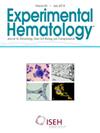Vesicle-mediated information transfer in cardiovascular cell differentiation
IF 2.1
4区 医学
Q2 HEMATOLOGY
引用次数: 0
Abstract
Extracellular vesicles (EVs)—including exosomes, microvesicles, and apoptotic bodies—are membrane-bound carriers of diverse molecular cargo such as nucleic acids, proteins, and lipids. They are increasingly recognized as critical mediators of information transfer during cardiovascular cell differentiation, development, diseases, and regeneration. Emerging evidence highlights the capacity of EV-encapsulated microRNAs (miRNAs) to drive cardiomyocyte differentiation and support angiogenesis. We recently discovered a novel EV-mediated mechanism termed “phenotypic synchronization of cells” (PSyC). When protein kinase A (PKA) is activated in pluripotent stem cells, the speed of mesodermal differentiation increases, partly through elevated EV-encapsulated miR-132. miR-132, transferred to neighboring cells with EVs, reactivates PKA signaling in recipient cells, synchronizing differentiation stages. Additionally, ex vivo assays reveal that EVs derived from PKA-activated cells can induce cardiomyocyte differentiation in early-stage embryos, underscoring the potency of EV-based signaling in shaping cardiovascular phenotypes. We recently uncovered a novel modality of vesicle-mediated intercellular communication, named direct intercellular vesicle exchange (DIVE), a distinct pathway enabling rapid and direct vesicle transfer between adjacent cells. By facilitating the direct traverse of nucleic acid-laden vesicles across the plasma membrane, DIVE may reinforce conventional EV-based signaling in cardiovascular differentiation. Together, these findings underscore the fundamental role of vesicle-mediated information exchange in orchestrating cardiac and vascular cell fates. Exploiting vesicle-mediated communication may open new avenues in regenerative medicine, disease modeling, and therapeutic interventions aimed at modulating cardiovascular cell function.
心血管细胞分化中囊泡介导的信息传递。
细胞外囊泡(EVs)——包括外泌体、微囊泡和凋亡小体——是多种分子货物(如核酸、蛋白质和脂质)的膜结合载体。它们越来越被认为是心血管细胞分化、发育、疾病和再生过程中信息传递的关键介质。新出现的证据强调了ev封装的mirna驱动心肌细胞分化和支持血管生成的能力。我们最近发现了一种新的ev介导机制,称为“细胞表型同步”(PSyC)。当蛋白激酶A (PKA)在多能干细胞中被激活时,中胚层分化的速度会增加,部分原因是ev包封的miR-132升高。miR-132被转移到具有ev的邻近细胞中,重新激活受体细胞中的PKA信号,同步分化阶段。此外,体外实验显示,来自pka活化细胞的ev可以诱导早期胚胎的心肌细胞分化,这强调了基于ev的信号传导在塑造心血管表型中的效力。我们最近发现了一种新的囊泡介导的细胞间通讯方式,称为直接细胞间囊泡交换(Direct intercell Vesicle Exchange, DIVE),这是一种独特的途径,可以在相邻细胞之间进行快速和直接的囊泡转移。通过促进携带核酸的囊泡直接穿过质膜,DIVE可能会加强心血管分化中传统的基于ev的信号传导。总之,这些发现强调了囊泡介导的信息交换在协调心脏和血管细胞命运中的基本作用。利用囊泡介导的通讯可能为再生医学、疾病建模和旨在调节心血管细胞功能的治疗干预开辟新的途径。我们最近发现了一种新的囊泡介导的细胞间通讯方式,称为直接细胞间囊泡交换(Direct intercell Vesicle Exchange, DIVE),这是一种独特的途径,可以在相邻细胞之间进行快速和直接的囊泡转移。通过促进携带核酸的囊泡直接穿过质膜,DIVE可能会加强心血管分化中传统的基于ev的信号传导。
本文章由计算机程序翻译,如有差异,请以英文原文为准。
求助全文
约1分钟内获得全文
求助全文
来源期刊

Experimental hematology
医学-血液学
CiteScore
5.30
自引率
0.00%
发文量
84
审稿时长
58 days
期刊介绍:
Experimental Hematology publishes new findings, methodologies, reviews and perspectives in all areas of hematology and immune cell formation on a monthly basis that may include Special Issues on particular topics of current interest. The overall goal is to report new insights into how normal blood cells are produced, how their production is normally regulated, mechanisms that contribute to hematological diseases and new approaches to their treatment. Specific topics may include relevant developmental and aging processes, stem cell biology, analyses of intrinsic and extrinsic regulatory mechanisms, in vitro behavior of primary cells, clonal tracking, molecular and omics analyses, metabolism, epigenetics, bioengineering approaches, studies in model organisms, novel clinical observations, transplantation biology and new therapeutic avenues.
 求助内容:
求助内容: 应助结果提醒方式:
应助结果提醒方式:


